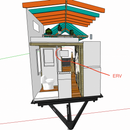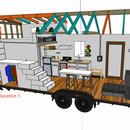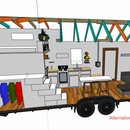ERV system efficiency in tiny house
In the middle of our tiny house build and am trying to square away the ventilation system.
First, we are using the twinfresh comfo erv. The house is 200sq ft total. The ideal plan is to install the erv in the 26 sq foot bathroom directly facing the doorway (see picture) to act as a bathroom fan for moisture removal during shower, and then run otherwise continually to do its job at bringing in fresh air to the entire house.
I have several concerns/questions regarding this idea and am looking for any advice. First, is this erv adequate for moisture removal in the bathroom or is that totally far fetched? I have read that you need 1cfm per square foot of bathroom and the Twinfresh is 32 cfm on high. Is this enough or does the typical rule not apply because it is such a condensed space? We live in an extremely wet climate (the pacific northwest) so minimizing moisture to prevent mold growth is a concern.
Second concern is if the location and positioning of the erv will adequately reach the air of the whole space? See the picture to see how it is positioned.
Third concern is if we have a 160 cfm hood vent for the range, is the erv going to provide make up air at a fast enough rate that we won’t be constantly creating a negative pressure in the house that will be forcing air in through cracks?
I am wondering if it would be better to put an exhaust fan in the bathroom for moisture and put the erv in a different location to better reach the air in the whole house (see pictures for alternative locations). If we do this I’m wondering if the vacuum effect will be even more of an issue and if we need to install a separate vent for make up air.
We want to get the most out of the erv and put it in the most efficient spot, as well as manage moisture properly as I am very sensitive to mold and our area is susceptible to it.
I don’t know much about this so any thoughts are greatly appreciated!
GBA Detail Library
一千年建筑细节的集合organized by climate and house part














Replies
Your entire house is only about double the size of a typical bathroom. I'd say that whatever humidity removal and ventilation requirements you have are common to the whole house. So having the ERV in the bathroom is probably fine. 32cfm is probably enough for continuous ventilation.
You can't rely on the ERV to supply any make up air for the range hood. It's intended to provide balanced ventilation.
Hi gmth -
ERVs do NOT actively dehumidify; they can only help maintain any differential in moisture content of the two streams of air. See this GBA article by Martin Holladay://m.etiketa4.com/article/misconceptions-about-hrvs-and-ervs.
I am sorry to say that finding mechanical equipment sized for spaces as small as a tiny house is a real challenge.
There are some devices that have some dehumidification and space conditioning (heating and cooling) capacity, such as the Minotair, but you would have to check with the manufacturer about how this sort of system can be sized/configured for your small space.//m.etiketa4.com/article/another-north-american-magic-box.
Peter
G.M.,
While Peter Yost is correct when he states that an ERV cannot actively dehumidify, introducing outdoor air into your house during the winter will tend to lower the indoor relative humidity (because cold outdoor air can't hold much moisture). In winter, outdoor air is dry. Although an ERV won't be as effective as an HRV at lowering your indoor RH in winter, it will still work.
During the summer, you'll need another strategy to lower indoor relative humidity.
Check out the Home Performance YouTube channel. They built their "Tiny Lab", a tiny house on wheels like yours, and have a very thorough video series detailing most of the steps and design strategies. If I remember right, they used the Panasonic WhisperComfort ERV which has settings as low as 10 CFM. In your tiny space very little ventilation will be required, and too much will result in a relatively large energy penalty as well as dry winters and damp summers.
They had a single exhaust in their system, located in the bathroom. Their range hood uses a dedicated powered makeup air duct.
>"We live in an extremely wet climate (the pacific northwest) so minimizing moisture to prevent mold growth is a concern."
Don't conflate precipitation levels with ventilation air humidity. They are not the same thing.
In the PNW its better to use an HRV if controlling indoor humidity is the goal.
Martin writes:
>"During the summer, you'll need another strategy to lower indoor relative humidity."
Not really.
It's a hard thing for many people living in the "-A" climates zones, but the air in the northwest is plenty dry even in summer. The PNW has some of the driest summertime outdoor air in the lower 48. HRVs or exhaust only ventilation is still going to purge rather than add moisture.
Despite copious rainfall in some parts of the PNW the outdoor dew point averages are lower than some parts of the Gobi desert. This is a DRY climate from an ventilation humidity point of view, and an ERV would be actively working AGAINST you for purging indoor humidity. An HRV would serve you much better.
The dew point of healthy comfortable 50% RH/70F wintertime air is 50F. Any time it's 50F or colder outside the dew point of the outdoor air is lower than that- period, full stop. During the summer comfortable and healthy 50%RH / 75F air has a dew point of 55F, and outdoor dew points that would hit the mold-promoting 70% RH @ 75F would be a dew point about 65F (which is rare enough that it makes page 1 news in Seattle when that happens, even though that's the mid-summer average in much of New England.)
The highest outdoor dew point averages in the PNW are in July, and even then stay below 55F for 2/3 of the hours even during the most humid weeks:
https://weatherspark.com/m/402/7/Average-Weather-in-July-in-Eugene-Oregon-United-States#Sections-Humidity
https://weatherspark.com/m/913/8/Average-Weather-in-August-in-Seattle-Washington-United-States#Sections-Humidity
Dana,
You've corrected me before on this point -- the fact that outdoor air in the Pacific Northwest is dry enough in summer to lower the indoor RH when outdoor air is used for ventilation -- and you're right. Once again, however, I repeated my mistake. Thanks for the correction.
Same goes for my comment as well regarding the Panasonic ERV. Noted!
considering the size of your space, you might be better off purchasing a portable thermoelectric dehumidifier (they are at about $50 on Amazon) than trying to size the AC system for de-humidification operation.